艾默生Control Techniques产品总介绍
- 格式:pdf
- 大小:17.17 MB
- 文档页数:51
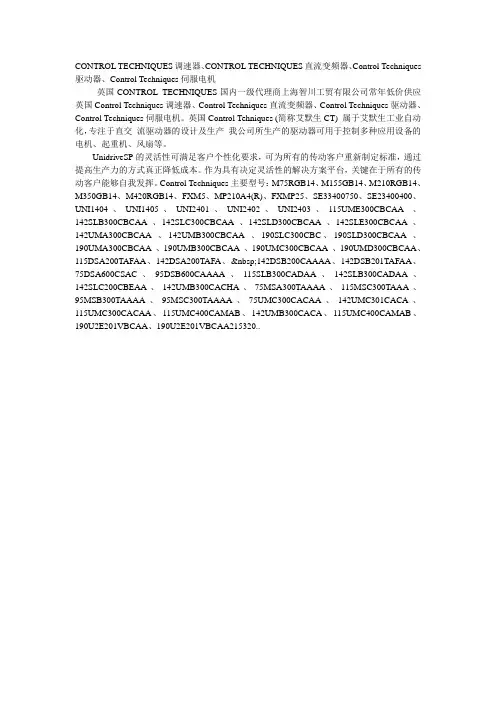
CONTROL TECHNIQUES调速器、CONTROL TECHNIQUES直流变频器、Control Techniques 驱动器、Control Techniques伺服电机英国CONTROL TECHNIQUES国内一级代理商上海智川工贸有限公司常年低价供应英国Control Techniques调速器、Control Techniques直流变频器、Control Techniques驱动器、Control Techniques伺服电机。
英国Control Tehniques (简称艾默生CT) 属于艾默生工业自动化,专注于直交流驱动器的设计及生产我公司所生产的驱动器可用于控制多种应用设备的电机、起重机、风扇等。
UnidriveSP的灵活性可满足客户个性化要求,可为所有的传动客户重新制定标准,通过提高生产力的方式真正降低成本。
作为具有决定灵活性的解决方案平台,关键在于所有的传动客户能够自我发挥。
Control Techniques主要型号:M75RGB14、M155GB14、M210RGB14、M350GB14、M420RGB14、FXM5、MP210A4(R)、FXMP25、SE33400750、SE23400400、UNI1404、UNI1405、UNI2401、UNI2402、UNI2403、115UME300CBCAA 、142SLB300CBCAA 、142SLC300CBCAA 、142SLD300CBCAA 、142SLE300CBCAA 、142UMA300CBCAA 、142UMB300CBCAA 、190SLC300CBC、190SLD300CBCAA 、190UMA300CBCAA 、190UMB300CBCAA 、190UMC300CBCAA 、190UMD300CBCAA、115DSA200TAFAA、142DSA200TAFA、 142DSB200CAAAA、142DSB201TAFAA、75DSA600CSAC、95DSB600CAAAA、115SLB300CADAA、142SLB300CADAA、142SLC200CBEAA、142UMB300CACHA、75MSA300TAAAA、115MSC300TAAA、95MSB300TAAAA、95MSC300TAAAA、75UMC300CACAA、142UMC301CACA、115UMC300CACAA、115UMC400CAMAB、142UMB300CACA、115UMC400CAMAB、190U2E201VBCAA、190U2E201VBCAA215320..。
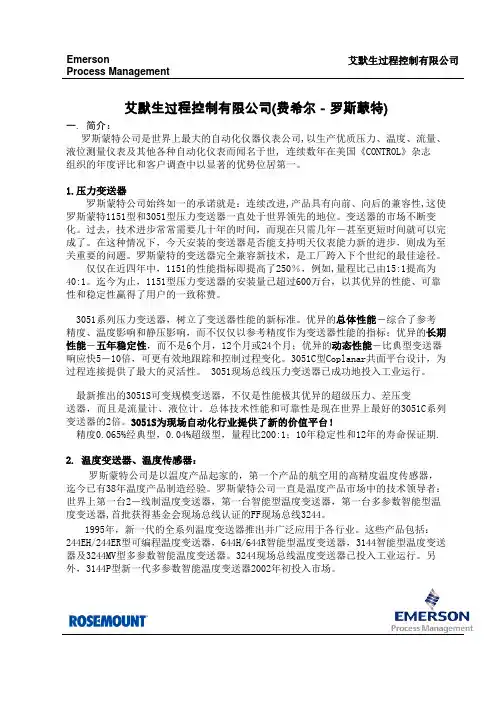
艾默生过程控制有限公司(费希尔-罗斯蒙特)一. 简介:罗斯蒙特公司是世界上最大的自动化仪器仪表公司,以生产优质压力、温度、流量、液位测量仪表及其他各种自动化仪表而闻名于世, 连续数年在美国《CONTROL》杂志组织的年度评比和客户调查中以显著的优势位居第一。
1.压力变送器罗斯蒙特公司始终如一的承诺就是:连续改进,产品具有向前、向后的兼容性,这使罗斯蒙特1151型和3051型压力变送器一直处于世界领先的地位。
变送器的市场不断变化。
过去,技术进步常常需要几十年的时间,而现在只需几年-甚至更短时间就可以完成了。
在这种情况下,今天安装的变送器是否能支持明天仪表能力新的进步,则成为至关重要的问题。
罗斯蒙特的变送器完全兼容新技术,是工厂跨入下个世纪的最佳途径。
仅仅在近四年中,1151的性能指标即提高了250%,例如,量程比已由15:1提高为40:1。
迄今为止,1151型压力变送器的安装量已超过600万台,以其优异的性能、可靠性和稳定性赢得了用户的一致称赞。
3051系列压力变送器,树立了变送器性能的新标准。
优异的总体性能-综合了参考精度、温度影响和静压影响,而不仅仅以参考精度作为变送器性能的指标;优异的长期性能-五年稳定性,而不是6个月,12个月或24个月;优异的动态性能-比典型变送器响应快5-10倍,可更有效地跟踪和控制过程变化。
3051C型Coplanar共面平台设计,为过程连接提供了最大的灵活性。
3051现场总线压力变送器已成功地投入工业运行。
最新推出的3051S可变规模变送器,不仅是性能极其优异的超级压力、差压变送器,而且是流量计、液位计。
总体技术性能和可靠性是现在世界上最好的3051C系列变送器的2倍。
3051S为现场自动化行业提供了新的价值平台!精度0.065%经典型,0.04%超级型,量程比200:1;10年稳定性和12年的寿命保证期.2. 温度变送器、温度传感器:罗斯蒙特公司是以温度产品起家的,第一个产品的航空用的高精度温度传感器,迄今已有38年温度产品制造经验。
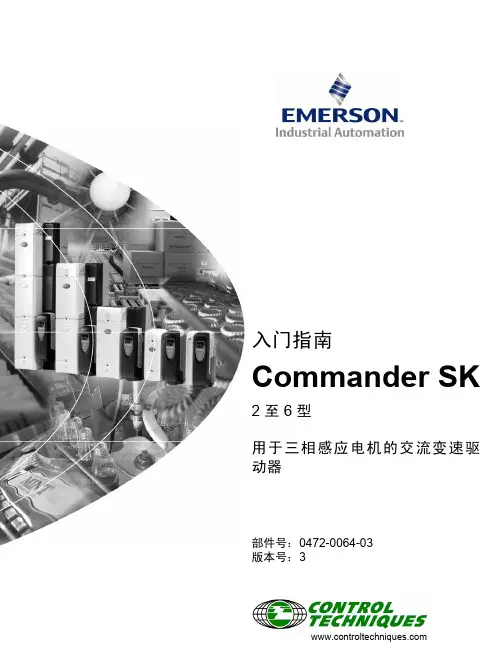





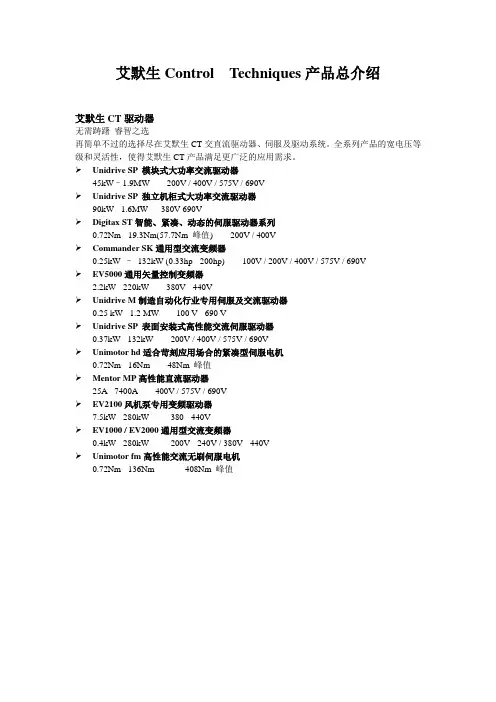
艾默生Control Techniques产品总介绍艾默生CT驱动器无需踌躇睿智之选再简单不过的选择尽在艾默生CT交直流驱动器、伺服及驱动系统。
全系列产品的宽电压等级和灵活性,使得艾默生CT产品满足更广泛的应用需求。
Unidrive SP 模块式大功率交流驱动器45kW–1.9MW 200V / 400V / 575V / 690VUnidrive SP 独立机柜式大功率交流驱动器90kW - 1.6MW 380V-690VDigitax ST智能、紧凑、动态的伺服驱动器系列0.72Nm - 19.3Nm(57.7Nm 峰值) 200V / 400VCommander SK通用型交流变频器0.25kW –132kW (0.33hp - 200hp) 100V / 200V / 400V / 575V / 690VEV5000通用矢量控制变频器2.2kW - 220kW 380V - 440VUnidrive M制造自动化行业专用伺服及交流驱动器0.25 kW - 1.2 MW 100 V - 690 VUnidrive SP 表面安装式高性能交流伺服驱动器0.37kW - 132kW 200V / 400V / 575V / 690VUnimotor hd适合苛刻应用场合的紧凑型伺服电机0.72Nm - 16Nm 48Nm 峰值Mentor MP高性能直流驱动器25A - 7400A 400V / 575V / 690VEV2100风机泵专用变频驱动器7.5kW - 280kW 380 - 440VEV1000 / EV2000通用型交流变频器0.4kW - 280kW 200V - 240V / 380V - 440VUnimotor fm高性能交流无刷伺服电机0.72Nm - 136Nm 408Nm 峰值Unidrive M0.25 kW - 1.2 MW 重载(0.33 hp - 1600 hp)100 V / 200 V / 400 V / 575 V / 690 V制造自动化领域客户需求的专业驱动器概述Unidrive M 是专为制造自动化应用而设计的,这是Control Techniques 的传统专业领域。
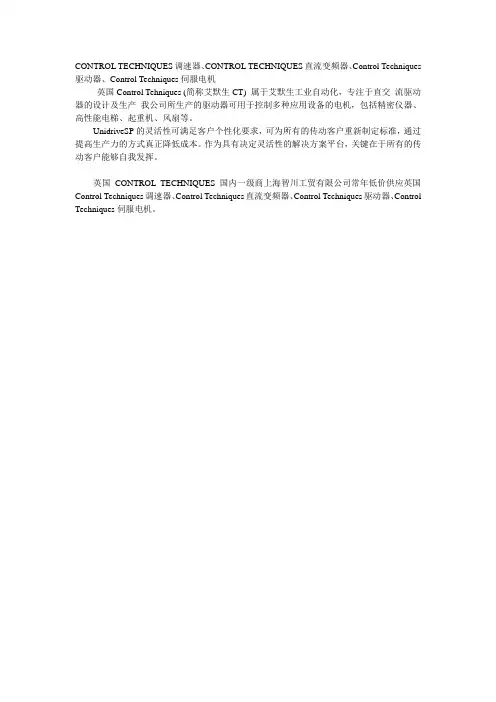
CONTROL TECHNIQUES调速器、CONTROL TECHNIQUES直流变频器、Control Techniques 驱动器、Control Techniques伺服电机
英国Control Tehniques (简称艾默生CT) 属于艾默生工业自动化,专注于直交流驱动器的设计及生产我公司所生产的驱动器可用于控制多种应用设备的电机,包括精密仪器、高性能电梯、起重机、风扇等。
UnidriveSP的灵活性可满足客户个性化要求,可为所有的传动客户重新制定标准,通过提高生产力的方式真正降低成本。
作为具有决定灵活性的解决方案平台,关键在于所有的传动客户能够自我发挥。
英国CONTROL TECHNIQUES国内一级商上海智川工贸有限公司常年低价供应英国Control Techniques调速器、Control Techniques直流变频器、Control Techniques驱动器、Control Techniques伺服电机。
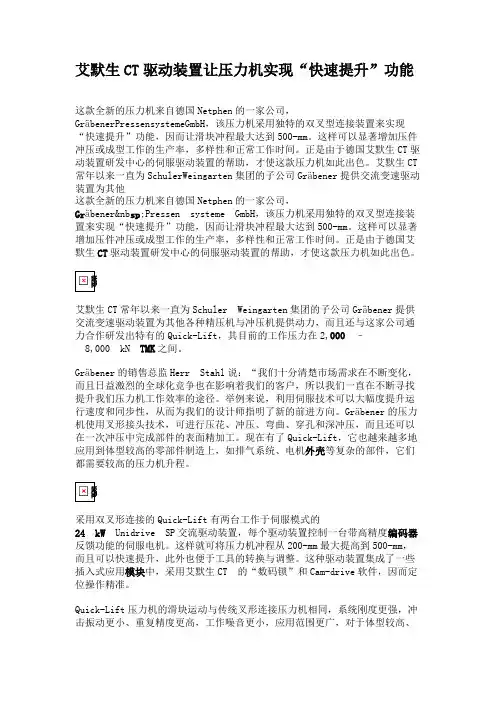
艾默生CT驱动装置让压力机实现“快速提升”功能这款全新的压力机来自德国Netphen的一家公司,GräbenerPressensystemeGmbH,该压力机采用独特的双叉型连接装置来实现“快速提升”功能,因而让滑块冲程最大达到500-mm。
这样可以显著增加压件冲压或成型工作的生产率,多样性和正常工作时间。
正是由于德国艾默生CT驱动装置研发中心的伺服驱动装置的帮助,才使这款压力机如此出色。
艾默生CT 常年以来一直为SchulerWeingarten集团的子公司Gräbener提供交流变速驱动装置为其他这款全新的压力机来自德国Netphen的一家公司,Gräbener&nb sp;Pressen systeme GmbH,该压力机采用独特的双叉型连接装置来实现“快速提升”功能,因而让滑块冲程最大达到500-mm。
这样可以显著增加压件冲压或成型工作的生产率,多样性和正常工作时间。
正是由于德国艾默生CT驱动装置研发中心的伺服驱动装置的帮助,才使这款压力机如此出色。
艾默生CT常年以来一直为Schuler Weingarten集团的子公司Gräbener提供交流变速驱动装置为其他各种精压机与冲压机提供动力,而且还与这家公司通力合作研发出特有的Quick-Lift,其目前的工作压力在2,000–8,000 kN TMK之间。
Gräbener的销售总监Herr Stahl说:“我们十分清楚市场需求在不断变化,而且日益激烈的全球化竞争也在影响着我们的客户,所以我们一直在不断寻找提升我们压力机工作效率的途径。
举例来说,利用伺服技术可以大幅度提升运行速度和同步性,从而为我们的设计师指明了新的前进方向。
Gräbener的压力机使用叉形接头技术,可进行压花、冲压、弯曲、穿孔和深冲压,而且还可以在一次冲压中完成部件的表面精加工。
现在有了Quick-Lift,它也越来越多地应用到体型较高的零部件制造上,如排气系统、电机外壳等复杂的部件,它们都需要较高的压力机升程。
艾默生Control Techniques Emerson Control Techniques 公司介绍Company Profile美国艾默生电气公司(以下简称Emerson,美国纽约证券交易所代码: EMR) 是技术与工程领域的全球领袖,在商业、工业和消费者市场中,为全世界的客户开发并提供创新的解决方案。
成立于1890年的Emerson,总部在美国密苏里州圣路易斯市。
Emerson通过网络能源、过程管理、工业自动化、环境优化技术、商住解决方案等业务为工业、商业及消费者市场客户提供创新性的解决方案。
五大业务平台:•过程管理•网络能源•工业自动化•环境优化技术•商住解决方案中国是Emerson在全球业务发展最快的地区之一。
自2002财年中国已成为Emerson仅次于美国的第二大市场。
七十年代末,Emerson通过首个技术转让项目在中国发展业务。
1992年在中国成立了第一家独资企业。
1993年10月,Emerson在上海成立了艾默生电气(中国)投资有限公司,这是第一家将投资性公司总部设在上海的美国公司。
从那时起,Emerson在中国的投资有了实质性的增长公司2012财年的销售额达244亿美元。
EMERSON艾默生Emerson公司总部美国密苏里州圣路易斯市艾默生工业自动化艾默生以科技融合工程技术锲而不舍、追求完美,在充满活力的世界范围为客户利益创造最佳解决方案。
艾默生品牌承诺艾默生工业自动化是Emerson 公司所属业务品牌,提供技术领先的生产解决方案,包括机械、电力及超声波等,为全球多种多样的行业提供最先进的工业自动化方案。
该业务品牌广泛的产品和系统应用于生产过程和设备,包括运动控制系统、物料连接、精密清洗、物料测试、液压控制阀、交流发电机、马达、机械动力传输驱动器和轴承等。
了解详细信息,请浏览CT (Control Techniques) 是艾默生工业自动化的下属公司。
我们的专项是驱动器的设计、生产和工程应用,并提供技术支持和售后服务。
EC10系列可编程控制器用户手册资料版本V1.0归档日期2006-06-26BOM 编码 31011281艾默生网络能源有限公司为客户提供全方位的技术支持,用户可与就近的艾默生网络能源有限公司办事处或客户服务中心联系,也可直接与公司总部联系。
艾默生网络能源有限公司地址:深圳市南山区科技工业园科发路一号邮编:518057公司网址:客户服务热线: 800-820-6510手机及未开通800地区请拨打:021-********客户服务投诉热线:0755-********E-mail:info@安全注意事项在开始操作之前,请仔细阅读操作指示、注意事项,以减少意外的发生。
产品及产品手册中的“危险、警告、注意”事项,并不代表所应遵守的所有安全事项,只作为各种操作安全注意事项的补充。
因此,负责产品安装、操作的人员必须经严格培训,遵守相关行业的安全规范,严格遵守本手册提供的相关设备注意事项和特殊安全指示,按正确的操作方法进行设备的各项操作。
本手册中,将安全注意事项分为“危险”、“警告”与“注意”三个等级。
危险:错误操作可能导致死亡、严重人身伤害或重大损失。
警告:错误操作可能导致人员的伤害或财产损失。
注意:错误操作可能导致设备损坏或财产损失。
设计中的注意事项应用时请务必设计安全电路,保证当外部电源掉电或可编程控制器故障时,可编程控制器的应用系统能安全工作。
设计中应考虑的方面包括:z务必在可编程控制器的外部电路中设置紧急制动电路、保护电路、正反转操作的互锁电路和防止机器损坏的位置上限、下限的互锁开关;z为使设备能安全运行,对重大事故相关的输出信号,请设计外部保护电路和安全机构;z可编程控制器CPU检测到系统异常后可能会导致所有输出关闭;当控制器部分电路故障时,可能导致其输出不受控制,为保证设备能正常运转,需设计合适的外部控制电路;z可编程控制器的继电器、晶体管等输出单元损坏时,会使其输出无法控制为ON或OFF状态;z可编程控制器设计应用于室内区域B和C注1的电气环境,其电源系统级应有防雷保护装置,确保雷击过电压不会直接施加于可编程控制器的电源输入端或信号输入、控制输出端等端口,避免损坏设备。
FeaturesSecure, reliable and mission-critical control capability providing “bumpless” automatic failover between redundant controllers.Diverse control capability using graphical control sheets combining modulating,sequential, sequence, and data acquisition.One-step data acquisition functionality through the definition of the I/O data base.Small footprint with low power requirements and fanless operation.Native interfaces to Ovation and WDPF I/O,both local and remote.Integrated virtual I/O capability for third-party OEM systems over Ethernet protocols.Non-volatile storage of application software,point database, configuration information, and operating tuning constants.Managed by a commercial, real-time operating system which supports multi-tasking and preemptive task scheduling to POSIX1003.1b open system standards.Integrated sequence of events capability with 1 millisecond resolution.Ovation ControllerEmerson Process Management’s Ovation expert control system incorporates a powerful controller for secure, mission-critical operations such as those of power and water plants. The Ovation Controller executes simple or complex modulating and sequential control strategies, performs data acquisition functions, and interfaces to the Ovation Network and various I/O sub-systems. It has the capability to originate up to 16,000 points.Process ApplicationsThe Ovation Controller is designed to meet the demanding requirements of a wide range of process applications. It performs numerous functions, including:Continuous (PID) controlBoolean logicAdvanced ControlSpecial logic and timing functionsData acquisitionSequence of events processingCold junction compensationProcess point sensor/limit checkingProcess point alarm processingProcess point conversion to engineering unitsProcess point database storageLocal and remote I/O interfaceProcess point tagoutStandard Controller FunctionsControl ExecutionThe Ovation Controller, with its Intel processor,is capable of simultaneously executing as many as five process control tasks at loop speeds ranging from 10 milliseconds to 30 seconds.Each control task is comprised of I/O processpoint input scan, the control scheme execution followed by an output scan. Two of the control tasks loop speeds are predefined at one-second and 100 milliseconds. The other three control tasks can have user-selectable loop speeds.Individual control sheets are user-assigned to one of these tasks, allowing control execution loop times to be appropriate to the functions being controlled.Control SchemeThe control scheme executed by the Ovation Controller is defined by building control sheets with an extensive set of algorithms. A control sheet is the control that is executed, the documentation of the control, and the online monitoring diagram that is used to run and diagnose the process. The controller can provide for the execution of up to 6,000 control sheets.Sequence of EventsIntegral sequence of events (SOE) processing capability is provided via the Ovation and Q-Line I/O subsystems and standard controller software. With a resolution of one millisecond, the SOEsubsystem records the sequence in which a user-defined set of digital input conditions occurred. In addition to the higher resolution time tag, the SOE points are usable in control schemes like any other I/O point including limit checking and alarming.Alarm ProcessingBased on each process point database definition, the Ovation Controller performs all of the limit and alarm processing functions typically associated with a data acquisition system (DAS). During the input scan associated with the control execution or the default one-second DAS scan. The status (including alarm status) of all points in the controller are updated and broadcast onto the Ovation Network.Extensive information is included within the status information broadcast. For example, the status may indicate a point has either:Exceeded the range of the sensorExceeded the user-defined limitsChanged statePassed an incremental limitIf desired, the alarm reporting can be delayed on a per-point basis by a user-specified time period. When coupled with a workstation, the Ovation Controller has the capability to report six independent alarm thresholds, defined as:Four high limitsUser-defined high limitHighest plus incremental limitsFour low limitsUser-defined low limitLowest plus incremental limitsThe workstation has the capability to sort alarms based on a user-selected alarm significance level. Alarms specified will be denoted as either alert or information when displayed on the alarm screen. Operator Interface ProcessingThe Ovation Controller performs the entire limit and alarm processing based on the database configuration for each point. However, the controller’s operator interface capability allows these functions to be suspended as necessary by the process state or operator action which is also logged. These include scan remove, alarm cutout, enter valve, alarm and limit checking suspension and similar functions, which are also under the Ovation security functionality. Controller TypesThe Ovation Controller can provide additionalcapabilities with add-on software licenses for SIM Controller, Advanced Controller, or both.Another licensed controller type is an Ovation Virtual Controller used primarily in Ovation Simulator systems.The SIM Controller is a standard controller that has the ability to be directed to use simulated I/O instead of the actual hardware I/O system.This capability allows the control schemes to be interfaced with a process model or simulation. A basic factory acceptance test process model allows the controller to be tested by simulating the basic I/O functions such as value and direction. The SIM Controller capability can also be used with other fidelity models, such as a High Fidelity process plant model supplied in an Ovation Simulator System. An Advanced Controller is an additional licensed software capability that provides the ability to run advanced functionality algorithms. These licensed algorithms include sootblowing, neural networking, fuzzy logic, MPC, DMX, and other advanced algorithms which can use the redundant reliable execution environment provided by the Ovation Controller.The Ovation Virtual Controller is a software licensed capability which recreates the Ovation hardware controller with RTOS on a Windows PC platform. It is used primarily in Ovation Simulator Systems which use non-redundant virtual controllers to decrease the hardware footprint. The Virtual controller has most of the interface attributes of a standard, SIM or advanced controller except for hardware I/O support.RedundancyThe Ovation Controller is designed to accommodate multiple levels of redundancy for key components, including:Ovation Network interfaceFunctional processor, memory, and network controllerProcessor power supplyI/O interfacesInput power feedI/O power supplyAuxiliary power supplyRemote I/O communications mediaThe standard hardware configuration for controller redundancy is a passive backplane base on which both a primary and a backup controller are installed. Redundant 24V power is connected to the unit which is individually distributed to the controllers. Each controller consists of two modules, one providing the processor, memory, Ovation networking, and additional networking connections. The other module provides the interface to both local and remote Ovation and Q Line I/O, plus internal powering.Fully redundant pairs of controllers are equipped with:Dual Intel functional processorsDual network interfacesDual processor power suppliesDual I/O power suppliesDual auxiliary power suppliesDual input power feedsDual I/O interfacesEach functional processor in the redundant pair executes the same application program, although only one accesses the I/O and runs in the control mode at a time. The partner processor runs in the backup, configure, or offline modes with differences between them alarmed.Control ModeIn the control mode, the primary processor functions as it would in a non-redundant controller. It has direct access to the I/O to read,write, and execute both data acquisition and control functions. In addition, the primary processor monitors the status and health of its backup partner’s processor and network.Backup ModeIn the backup mode, the backup processor performs diagnostics and monitors the status and health of the primary processor. The backup processor maintains up-to-date data by polling the contr ol processor’s database memory and receiving all of the information that the control processor sends over the Ovation Network, including: process point values, algorithm tuning constants, and variable point attributes.Automatic Failover ControlThe redundancy function of the Ovation Controller is equipped with automatic failover control; if the processor in control mode fails, watchdog detection circuitry disables the I/O interface of the primary processor and informs the backup processor of the failure. The backup processor then takes control of the I/O bus and begins to execute the process controlapplication program and broadcast information over the Ovation Network.Ovation Controllers use a continual process of control memory updating to keep both the control and backup processors synchronized.This process uses either the Ovation Network or a private network connection. The employed method is user selectable depending upon control task requirements or available network port usage. This allows the algorithms to track the output values, pass the information upstream, and apply the data during the first pass of execution. The result is a bumpless failover, even in the case of a malfunction.A full range of events can trigger automatic failover, including:Control processor failureNetwork controller failureI/O interface failureRemoval of power from the control processorControl processor resetOnce the control is passed to the backup processor, the failed processor may be powered down, repaired, and powered back up with no harmful effects on the executing control strategy.On restart, the repaired processor will detect that its partner is in control and assume the backup role. The processor in control will detect the presence of the backup processor and adjust forredundant operation.Open ArchitectureThe open architecture of the Ovation Controller uses a powerful real-time operating system running on PCI bus PC architecture. This design allows rapidly advancing technology to be easily integrated into the system—protecting your investment in software.Real-Time Operating SystemFunctionsThe Ovation Controller processes data for realtime control and communication functions using a commercially available, multi-tasking, real-time operating system (RTOS). It executes and coordinates the control of multiple application areas by using multi-tasking with preemptive priority scheduling. It communications with theOvation Network and other systems via TCP/IP protocol, and some basic routing functions and offers general resource management within the controller. Ovation Controller HardwareThe Ovation Controller is built to open industry standards using Intel Processors and PCI bus technology. The advantage is that as newer technologies evolve they can be incorporated while retaining you investment in Ovation controller software is protected.This foundation also provides the portability so that Ovation Controller software can be run on other available platforms and operating systems.The Ovation Virtual Controller used in Ovation Simulator systems runs on a standard Windows OS on standard PC hardware and does not require actual I/O interfaces.The hardware platform and the operating systems for the Ovation Controller, based on industry standards, offer the followingadvantages:Minimal cost and complexity of hardware and software upgrades.Increased ability to track advances in technology。